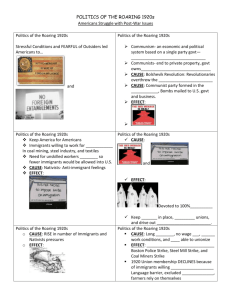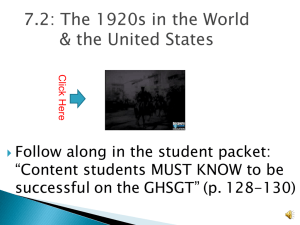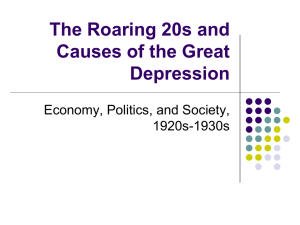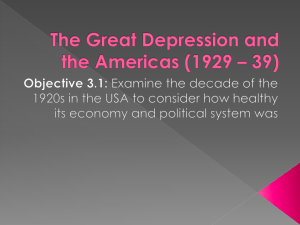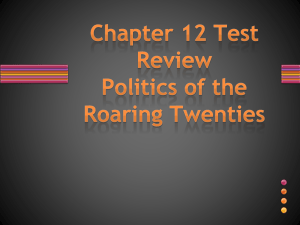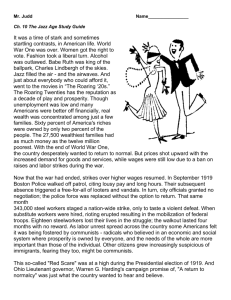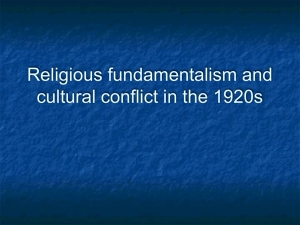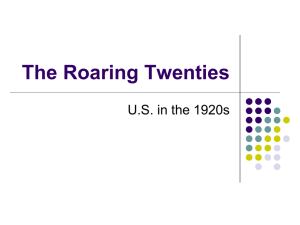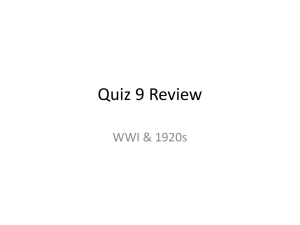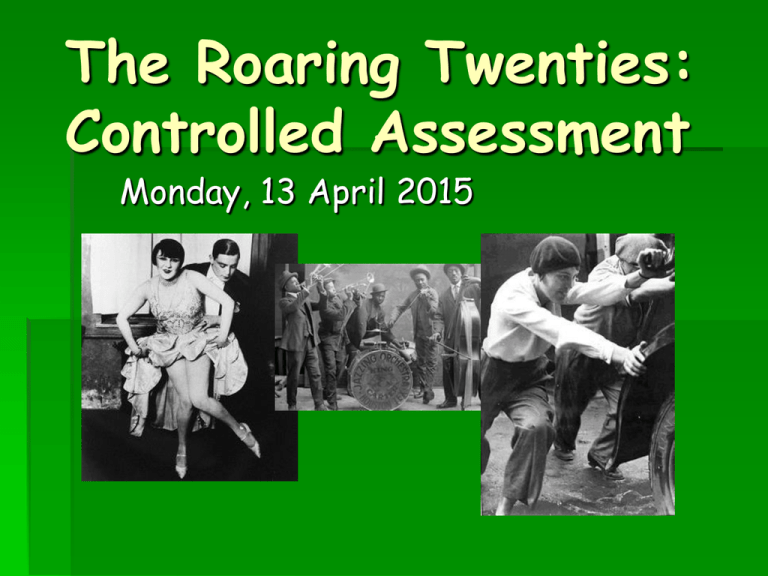
The Roaring Twenties:
Controlled Assessment
Monday, 13 April 2015
Y10 Controlled
Assessment
Assessment for Learning
Did everyone benefit from the roaring twenties?
Explain your answer.
(50 marks)- 2000 words
Did everyone benefit from the
Roaring Twenties? Explain your
answer (50 marks)- 2000 words
10 marks- Knowledge and Understanding.
15 marks- Explanation and Analysis of concepts.
Causes, consequence, continuity, change and
significance within a historical context. Linking
paragraphs together.
25 marks- Analysis and Evaluation of source
material (primary and secondary). Show
understanding that history can be interpreted
differently.
What do I do first????
Brainstorm areas that are relevant to
answering the question…
The 1920s benefitted
people
The 1920s did not
benefit people
Technology
Organised crime and
gangsterism
Sport
KKK
Entertainment
Immigration
Economy
Prohibition
Flappers??
Farmers
Then what?
Make a plan.
What areas do you intend to examine in your essay?
What will your arguments be? What sources do you intend to
use to support your arguments? Can you find additional sources
that are not supplied to you in the booklet? (can you make your
response a bit unique?)
How will you evaluate them? (comment on their value)
This plan will need to be handed in for assessment before you
go any further.
Then what?
Choose one area to study.
Look for sources first. Try to find ones that show more than one
argument. (This will allow you to generate debate and get a better
mark)
What do the sources show in that particular area? Was the period
roaring? For all? How roaring? Did all people in that particular group
share the same experience?
What does your evidence prove? I.e. use the source, “This source
suggests…”
Evaluate the source – “This source is useful because…”
Finally, link your argument back to the question – “Therefore, the
1920s were a time of progress in the area of……. Because….”
How do I start it off Miss….
Introduction. What is an effective
introduction?
You must use your own knowledge to set the
question in context (What is happening in
America at this time that relates to the
question?)
Tell the reader what you think, what you are
going to prove. Then spend the rest of your
answer proving you are right.
A good introduction
For many people in America during the 1920s, the decade was a time
which could certainly be called ‘roaring’– economically, technologically
and socially. Women enjoyed new freedoms, there were more
consumer goods in society, enriching the lives of many. 20% of all
Americans owned a motor car by the end of the period – compared to
1 in 7000 in Russia! In sport too, the 1920s was a golden age and for
the first time, sports stars enjoyed celebrity status. However, for
many, the 1920s was not a time of progress. Organised crime became
glamorised and many major cities descended into lawlessness – most
notably Chicago. Racism also flourished too as a result of black people
trying to improve their lives by migrating North in the hope of finding
a better job. Around 5 million people joined the KKK in the 1920s
which shows that the decade can be one that is described as one of
‘hate’. The changes for women too were seen by the older generation
as a period of decline – moral standards were slipping and this was
leading to major damage for society in general. I intend to argue that
the 1920s were a time to be called ‘roaring’ for many but this
experience was not consistent and that for many, things even got
worse.
Getting started. Your first paragraph
Each paragraph should begin with what you
are going to argue in that paragraph.
Not a fact, not a statement, an argument.
Try not to write in the first person either
and ALWAYS WRITE IN THE PAST
TENSE!!!
Possible factors
You are to choose 4 factors:
Farmers (Rural South did not benefit as much from the
economic boom)
Industry (Urban centres: Chicago, New York, Los Angeles
(Film). Rise of Henry Ford, coal industry declines whilst nylon
industries increase)
Women (New found freedom v moral decline, urban v rural)
Immigrants (arguably did not benefit much, Sacco and
Vanzetti, American Dream)
Race (resurgence of KKK v the rise of Jazz music and its
popularity)
Organised crime (rise of the gangsters: Al Capone and
bootleggers)
Rise of liberal thinking (the Monkey trial and the ‘Bible Belt’)
You must assess if the group benefitted to a large extent,
some extent or not at all (and be critical within that too!)
Use the source and then comment.
Or you could choose a theme
Culture: flappers, film, sport, music, drinking
culture and Prohibition, rise of celebrity (even
Capone!)
Economics: Ford, new industries (consumer goods),
old v new (economic shift from Boston and
Washington to New York and L.A.)
Social: women, living conditions, experience of black
people (segregation), experience of immigrants,
impact of advertising and living beyond your means,
rise of organised crime
Religion: new ideas v traditional thinking,
geographical differences (liberal West v south and
mid-west ‘Bible states’, theory of evolution (Monkey
trial) and the atheists v fundamentalists
For example
“For many women, the 1920s was a period when they saw increased
freedoms and became liberated from the traditions that had kept
them suppressed for decades and so they did benefit. Many
‘flappers’, as they were called, rebelled against the way women had
been treated for years and hated the fact that men were given
better treatment in the workplace. They rebelled because they had
been given a taste of independence in WWI and they wanted this
independence to continue – many historians have called this period
‘the flapper phenomenon’. Not all women enjoyed these freedoms
though, flappers were mainly middle class girls from the north and
visual evidence from the time shows some wearing short dresses,
smoking cigarettes and wearing make up. Other photographs support
these images and show them enjoying themselves dancing high energy
dances, like the Charleston, and held onto their partners without
wearing gloves! Images like this suggest that for these women, the
decade was indeed roaring as their lifestyles improved significantly
for the better. However, many older and more traditional people
hated these changes and the President of Florida University in 1923
said “…the stockings and short skirts are born of the devil..” This
source suggests that many saw flappers as an example of the evils of
modern life. This could be supported by the fact that many more girls
were having sex before marriage – in 1900, 80% of girls were virgins
on their wedding night whereas in 1920, only 31% were. Therefore
for many girls, but certainly not all, the 1920s were a period that
could be called roaring.”
Source selection
I need to find at least 2/3 pieces of
historical evidence to support my
argument in each paragraph.
Try to vary them if you can i.e. don’t
just use photographs for example.
Which sources prove your point?
Source evaluation
In your essay, you must try to comment on the value
of at least 3 sources.
(purpose/knowledge/authorship/cross reference)
You do not need to criticise them (You will do in your
exam next year!!) but you will get credit if you are
able to comment on its particular value.
E.g.. “The photograph is particularly useful for
revealing the lack of progress made in the 1920s as
the image is clearly portraying the KKK in a brutal
light and was taken to try and discredit these
people and inflame the protest movement”
Next paragraph
Ideally, you would try to link your paragraphs together, to
demonstrate that factors can be inter linked and have impacts
on other factors. If you can’t, the maximum mark you will get
is an A.
For example, did all people experience the same things?
Did they experience them at the same rate?
Are any factors more important than others?
Can you prove your opinions, with hard evidence?
Can any of the factors be contributory in isolation, or do they
arise as a result of other factors?
Conclusion – What is a good
one?
The purpose of your final paragraph is a hugely
important one – you must summarise your main
points discussed in your analysis to answer the focus
question.
Do not introduce new material.
Use the words in the question to help you structure
what you write. It should be about 200 words long
too for it to be a good one. A few sentences is not
adequate in a piece of work of this nature.
So…
As a class, what should be on our final ‘tips’
page…
. Don’t drift into narrative, stick to the Q
. Link all points back to the Q
CONSISTENTLY!!! (i.e. use the word
benefit)
. Use relevant sources that back up your
point
. Identify, explain, support, link!
. Intro – Context, understand the Q, outline
the argument.
What should you do now?
You will need to give a paragraph into
your teacher every week for them to
assess
You must make this your priority over the
coming months as this is worth 25% of
your overall GCSE grade!
There are loads of good websites to get
you started e.g.
http://www.johndclare.net/America5.htm

